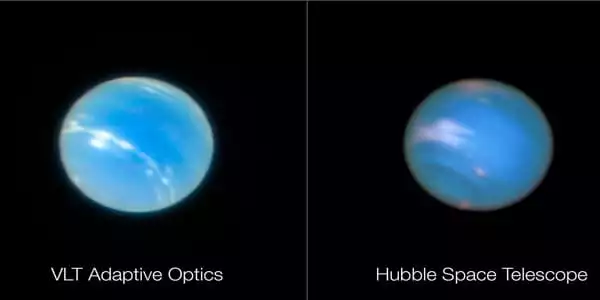Observations spanning two decades revealed an unexpected cooling of the solar system’s most distant planet, Neptune, during its astronomical summer. Neptune orbits the sun at a distance 30 times greater than Earth, with one year lasting 165 Earth years. Seasons on the ice giant are also far longer than those on Earth, lasting more than 40 Earth-years.
Neptune’s cycle around the sun takes about 165 Earth years, which implies its seasons each last for 40 years. That’s almost 160 times longer than one of our seasons, yet it’s not even the strangest part, according to new study published in the journal Planetary Science.
Over the last two decades, when the Earth entered its southern summer, astronomers witnessed its average global temperatures plunge by a startling 14 degrees Fahrenheit (8 degrees Celsius).
“This development was unexpected,” said Michael Roman, a postdoctoral research associate at the University of Leicester and the paper’s primary author. “Since we’ve been studying Neptune throughout its early southern summer, we’d expect temperatures to gradually rise, rather than fall.”
The temperature oscillations may be related to seasonal changes in Neptune’s atmospheric chemistry, which can vary how effectively the atmosphere cools. However, random fluctuation in weather patterns or even a response to the 11-year solar activity cycle could have an impact.
Michael Roman
The researchers examined observations in the heat-carrying infrared region of the light spectrum obtained from 2003 to 2018 by some of the world’s best telescopes, including the European Southern Observatory’s (ESO) Very Large Telescope in Chile, the Keck and Subaru Telescopes in Hawaii, and NASA’s Spitzer Space Telescope. The observed cooling, however, was not uniform, according to the researchers.
Measurements of Neptune’s stratosphere, the planet’s second-lowest layer of the atmosphere, found a warming trend above Neptune’s south pole. This data collection, which only included data from the years 2018 and 2020, shows rapid warming of nearly 20 degrees F. (11 degrees C). According to the researchers, such polar warming has never been detected on Neptune before.
However, observations of the distant Neptune have only been possible for the past few decades, and scientists know very little about the natural passing of the seasons on the planet.

“Our data cover less than half of a Neptune season,” Glenn Orton, Senior Research Scientist at JPL and research co-author, stated in a statement. “As a result, no one expected to witness substantial and rapid changes.”
Scientists aren’t sure what causes the surprising temperature variations, but they suspect it has something to do with the sun’s 11-year cycle of the activity or the cyclical ebb and flow of sunspot production by the star.
“The temperature oscillations may be related to seasonal changes in Neptune’s atmospheric chemistry, which can vary how effectively the atmosphere cools,” Roman explained. “However, random fluctuation in weather patterns or even a response to the 11-year solar activity cycle could have an impact.”
Previous research revealed a relationship between the number of sunspots and Neptune’s brightness. The new research also discovered evidence of a probable link between the solar cycle, the brightness of clouds in Neptune’s atmosphere, and the temperature of its stratosphere.
Scientists anticipate that future studies may shed additional insight into the mysteries of the faraway world. The James Webb Space Telescope, the most powerful space observatory ever built, is projected to make significant advances in our understanding of Neptune and the other solar system ice giant, Uranus.
The researchers also speculate that general stratospheric variations, or just the quantity of brilliant clouds floating about Neptune, may have caused the blue gas giant’s thermal brightness to fluctuate unexpectedly. But, for the time being, all of these choices are purely hypothetical.
“The exquisite sensitivity of the space telescope’s mid-infrared instrument, MIRI, will provide unprecedented new maps of the chemistry and temperatures in Neptune’s atmosphere, helping to better identify the nature of these recent changes,” Leigh Fletcher, a planetary scientist at the University of Leicester and co-author of the study, said in a statement.
















